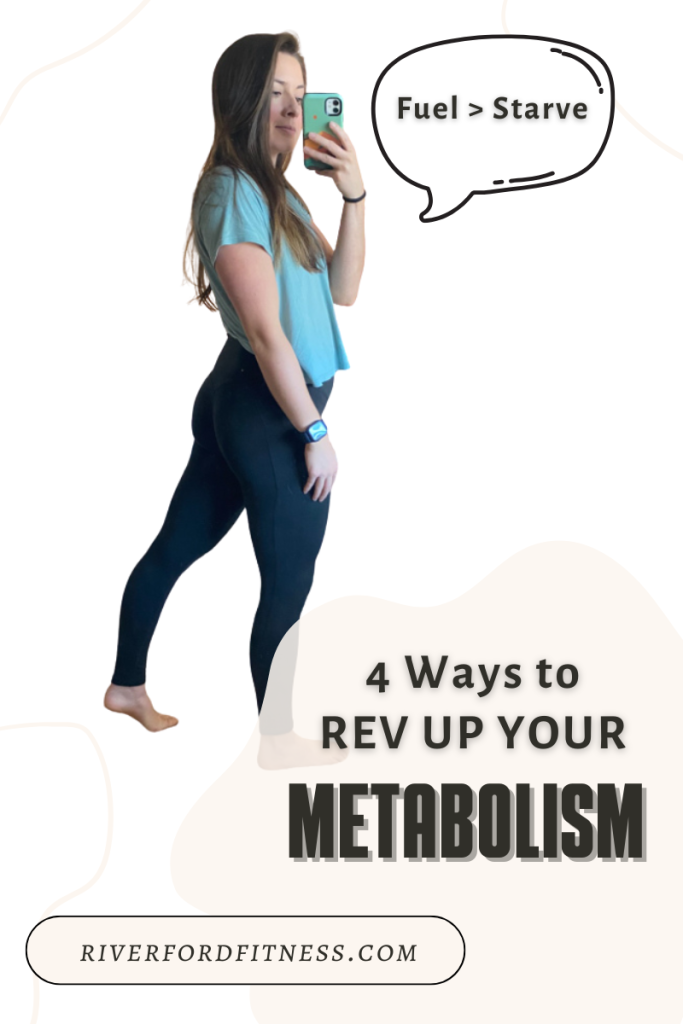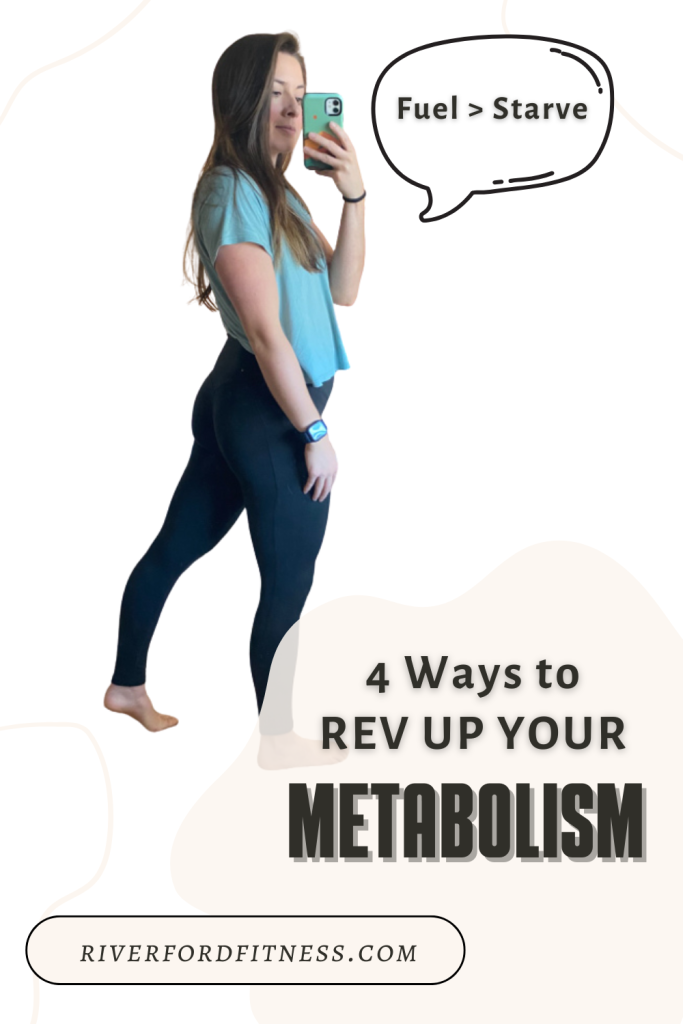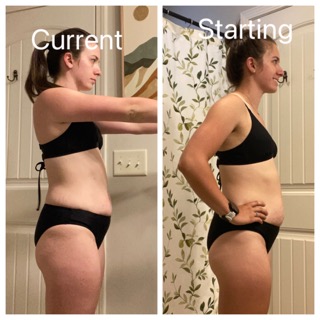Everyone is talking about this. I hear it in coffee shops, church groups, and playgrounds alike; ‘my metabolism is slow’ to ‘that has too many calories’ and everything in between. Most people don’t actually know what metabolism or calories mean, or how to use them to optimize reaching their goals.

I’ll be honest, I never said those things. I was an athlete. A child (and adult) with ADHD, emphasis on the hyperactive. Before I had my four kids in four years I maintained a lean body composition from my sports and personal need for movement. I’m what other would have called genetically blessed.
That’s just the thing though.
It’s not genetics most of the time. Often it’s not so much that your metabolism has slowed down…It’s that you have slowed down.
What four babies did to my metabolism…not what you think
One. Two. Three. Four. That’s how many sweet little babies God blessed me with. What else did he bless me with in that season? Some extra body fat, cranky hips, and a number on the scale I had never seen before.
Let me tell you. Taking four kids on a walk to get your 10k steps is no easy feat. Usually, I’d spend more time getting them ready to go than actually walking. The weight didn’t come off right away because I was spending a lot of time figuring out nursing and mothering four small very savage boys. Combine that with lack of sleep and picky kids, I was adding extra calories to my plate that my body couldn’t utilize so my weight plateaued after the initial postpartum weight loss from fluid and nursing.
167 lbs. It lingered for months.
I thought breastfeeding and motherhood burned calories? Apparently not enough. Did my high metabolism suddenly tank?
No. My output changed along with my input. Double whammy.
Sometimes it’s metabolism ADAPTATION
And there’s an easy solution for it. But I’m not sure you will love it at first.
Hear me out. When you’ve been chasing low calories for an extended period of time your body downgrades. You’re body is smart.
Your body is designed to survive, not suffer. So when we continuously give it less than it needs for months and years, it does things to optimize and protect itself.
What your body does on extended low calorie Deficit
When your body doesn’t get enough fuel for a long time, it doesn’t just shrug and give up—it adapts. And honestly? It’s brilliant at survival. The problem is, those survival strategies make it feel like your metabolism has “slowed,” when really, it’s protecting you.
The audacity!
Metabolism Down Regulating Signs
For example, have you ever noticed your hair shedding more than usual when you’re under stress or eating less? That’s your body deciding shiny hair isn’t essential for survival. It pulls nutrients away from hair and nails and reroutes them to keep your heart and lungs running.
You might also feel cold all the time. That’s not in your head—it’s your thyroid dialing things down to conserve energy. Less heat production means your core systems can stretch the calories you are eating a little further.
Then there’s your movement. Not your workouts, but the little things—fidgeting, pacing, walking around the house. This subconscious activity is called NEAT (non-exercise activity thermogenesis), and it quietly drops when energy is scarce. You don’t even realize it’s happening, but your body is conserving.
Hormones shift too. Women may lose their cycles, men may notice lower testosterone, and everyone feels the effects of hunger hormones going haywire. Ghrelin (your hunger signal) ramps up, while leptin (your fullness signal) drops, which is why you feel like you’re starving even on the same foods.
And let’s not forget fatigue and brain fog. Without enough fuel, your body slows energy to the brain, leaving you sluggish, irritable, and unable to think clearly. Even muscle—the very tissue that supports a strong metabolism—starts breaking down because your body will burn it for energy if it has no other choice.
Your body isn’t broken. It’s adapting the only way it knows how: to survive, not to suffer. The issue is that these adaptations make fat loss harder the longer you stay stuck in a deficit.
Grab your fuel to perform guide
Stop second-guessing your meals. This free guide shows you how to eat more, train smarter, and rev up your metabolism—without living in a calorie deficit.

Some truths about metabolism and calories
If you have hit a fat loss wall or experienced any of the symptoms above, I promise, it’s not you! You haven’t failed! You’re body is simply smarter than your ‘skinnytok’ feed and that curated pinterest board of low cal recipes.
Here’s the truth: calorie deficits aren’t the problem. I use deficits in my own training and for my clients with success. The problem is living in one forever without knowing how to come out of it when you’ve reached your goal.
The real solution? Fuel at maintenance-or above. When you show your body it’s safe, it responds beautifully. Later, when you re-enter a deficit strategically, it’ll feel like a tool not a punishment.
My experience: revving up my Metabolism
For the last year, I mostly ate at maintenance or above. I listened to my hunger cues, and for a few months I didn’t even track.
And yes—I gained weight.
I know that’s what you’re afraid of. Honestly, I was too. I originally started writing this blog to convince myself not to go into a maintenance phase. But my own symptoms of living in a low-calorie deficit for too long forced me to live out the truth I tell clients all the time. My body wasn’t broken—it was just doing its job.
This lifestyle isn’t only about what you look like. It’s about how you feel and what your body can do.
Pics from November 2024 and February 2025 when staying around 1600-1700 cals.
May 31, 2025 after spending about a only a few months at maintenance (2,000) or above (2500+) and working out less.
And here’s the step-by-step of what happened when I finally fueled my metabolism:
Step 1: I gave my body permission to eat more.
At first, it was uncomfortable. I was sure every bite would turn to fat. But I made a choice: instead of obsessing over every calorie, I focused on hitting my protein, building balanced meals, and letting myself feel full for the first time in years. The difference showed up quickly—my energy came back, my mood evened out, and I wasn’t freezing all the time.
Step 2: I pulled back on over-training.
For years, I equated more workouts and more steps with better results. But when I cut back from daily two-hour sessions and 15,000 steps, something unexpected happened: my body thanked me. My glutes grew more when I was recovering than when I was grinding. That was my metabolism using fuel for growth, not just survival.
Want Results, without Second guessing?
Step 3: I built real muscle.
Yes, the scale went up. But it wasn’t all fat. My strength skyrocketed. I could see the shape of my body changing in ways that “being lean” never gave me. I looked athletic, not just smaller. That’s when I realized the scale couldn’t tell me what my metabolism was truly doing.
Step 4: I trusted the process.
This one was the hardest. There were weeks I doubted everything. But I reminded myself: my body deserved safety. Gaining muscle was progress, not failure. Fueling wasn’t weakness—it was strategy.
Fast-forward to now: I’m in a cut again, and it’s nothing like before. I still get hungry (that’s normal in a calorie deficit), but it’s not unbearable. My energy holds steady. I can train hard. And I don’t feel like I’m clawing my way through every day. That’s what a primed metabolism feels like.
The Takeaway
Metabolism adapts to the story you tell it. If the story is “we’re starving,” it slows down. If the story is “we’re safe and we build,” it ramps up. The goal isn’t to avoid calorie deficits forever—they’re a valid and useful tool. The goal is to use them strategically, with a strong metabolism backing you up.
That’s the difference between punishment dieting and sustainable fat loss.































